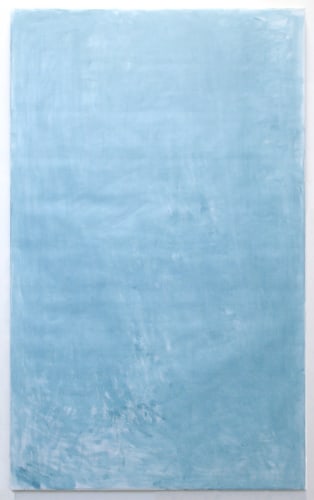
Fide, 2007, oil on linen, 72 x 44 inches (182.9 x 111.8 cm)
Top 10 from the Sao Paulo Bienal
By David Ebony
September 25, 2012
This spring in São Paulo a number of prominent exhibitions are invigorating the art scene. A Caravaggio show generates daily lines around the block at the São Paulo Museum of Art downtown ["Caravaggio and his Followers," through Sept. 30]. The first-ever museum survey for Rio-based art star Adriana Varejão currently fills the São Paulo Museum of Modern Art in Ibirapuera Park [through Dec. 16.]. And the highly praised 30th São Paulo Bienal, "The Imminence of Poetics," recently opened in the adjacent Oscar Niemeyer Pavilion and the other sprawling galleries of the Bienal Foundation building plus a number of off-site venues [through Dec. 9].
South America's largest contemporary art survey, first launched in 1951, the São Paulo Bienal is the second oldest biennial in the world after Venice's (which began in 1885). In terms of scale, the São Paulo Bienal is manageable relative to its Venetian counterpart, but the main exhibition still requires at least a full day to see.
Curated by Luis Pérez-Oramas, the Venezuelan-born curator of Latin American art at New York's MoMA, with co-curators Andre Sévero, Tobi Maier and Isabela Villanueva, the Bienal features some 3,000 pieces by 111 artists from around the globe. Many works were created specifically for the show. In addition, the Bienal hosts an extensive program of performances and lectures. The loose yet effectively unifying theme of poetics has apparently afforded participating artists a larger dose of artistic license than usual in big international shows.
The curators arranged the show under several sub-categories, employing broad umbrella terms like "Survival," "Drifts," "Voices" and "Alterforms" that make almost anything possible. Rather than a theory-driven event, the Bienal struck me as an exhibition united by the creative act, an attitude toward art making that favors hands-on fabrication, low-tech devices and a meditative sensibility.
At the exhibition's entrance, Guy Maddin's pulsating multi-screen video projection of archival Hollywood footage and newly minted images pulls viewers in to meander through a network of some dozen large, freestanding screens. Prominent throughout the show are interactive displays and films and videos that highlight an individual's actions and interactions with others—or with the environment—instead of efforts geared toward more conventional narrative structures. Pioneers like Allan Kaprow and Robert Smithson are at home here. And labor-intensive pieces prevail, such as the embroidered fabric compositions by New Yorker Elaine Reichek, as well as Michel Aubry's unforgettable re-creation of fabled director and actor Erich von Stroheim's wardrobe-filled dressing room on the set of Jean Renoir's Grand Illusion (1937).
The exhibition's strengths are in sculpture, installation and video. The curators seem not to have extended their generous poetic umbrellas to painters. Compared with other works on view, most of the paintings here are lackluster and subpar. Nevertheless, there were several highpoints in the medium, and a number of them were candidates for the Top 10. Here are the Bienal standouts:
6) John Zurier
At first, John Zurier's barely-there abstract paintings seem derivative. They perhaps belong alongside the spare, abject paintings that critic Raphael Rubinstein has referred to in the pages of A.i.A. as "provisional painting." However, the California painter's large, wistful monochromes eventually seduce. Certain pieces, such a large (about 6-by-4 feet), deep viridian green composition, conjure a forest landscape by Casper David Friedrich. In these instances, it seems as if Zurier were fearlessly pursuing the sublime.